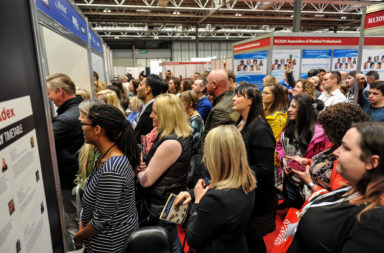Disability needn’t be a barrier towards taking up artistic pursuits. Able spoke with leading mouth and foot painter, Tom Yendell about his story and passion to get more disabled people involved in art.
How did you came to first pick up art materials and how does your disability affect your artistic technique?
Firstly, I don’t really see myself as having a disability because I’ve done everything I’ve wanted to do; it’s just that I’ve done it in a different way. I was born as a Thalidomide baby without any arms so I grew up using my feet, my mouth and my chin all the time. When I was very young I drew and painted with my feet. When I was about 10 years old and was getting a bit big to sit on tables at school I swapped over to using my mouth.
Like many boys I wasn’t very academic – quite lazy and happy to sit at the back of the class if I could get away with it but the thing I really did enjoy was art. I went to a fantastic school for disabled kids called Treloar’s in Hampshire and had a fantastic art teacher and for me it was a natural progression when I finished there to study at Hastings College. I did my degree at Brighton.
You could have used artificial limbs…
I’ve always said that until they make an artificial arm that is as good as anybody else’s and I don’t have to think about what I ‘m doing, why bother? I can do everything that I need to do already, so why have something that is inhibitive rather than helpful?
Also it was for society: there were 458 Thalidomide babies that had been born and society was saying, ‘We don’t like the look of them’. I think we were given the artificial arms to make us look as normal as possible. They were more of a hindrance to me than a help.
You obtained an Honours Degree in Expressive Arts from Brighton University. Was it difficult moving into an inclusive environment?
When you’re at school with other disabled kids – other ‘unique kids’ as I like to call them, you’re amongst friends and you’re amongst people that understand. As soon as you go into a college where you’re the odd one out it is very difficult. Being different than the others was quite difficult. It took me maybe a year while I was on my foundation course to get over that. I actually joined a physically handicapped and able bodied club (‘Phab’) when I was younger. I immersed myself in mixing with other people.
Isn’t everyone trying to be the ‘odd one out’ at art college?
I did an expressive arts degree: a third of it was visual art, a third of it was art history and a third of it was theatre. My final performance for my degree was about a guy called Thomas Crippen who was a circus performer back in the 1800’s, a man with no arms just like me. I had a massive pair of arms made out of fabric and hung them on the back of the curtain and when the audience came in I was kind of standing there sort of crucified – arms outstretched. I had a friend who came on as the ringmaster and he said: ‘I’d like to introduce you to the amazing Thomas Crippen, the man with no arms’ and I jumped out and all I had on were my speedos. It was really a way of ‘coming out’ for me – showing all of the people that I’d known for the previous years, this is me. Up until that point I always used to wear a jacket and after that it really didn’t bother me at all.
Your degree is in Expressive Arts; were you able to express you identity as a disabled person?
The fact that I was born with no arms has never come into my life, I just don’t see it. I don’t get it. We’re having a big discussion at the moment over the fact that our trust fund is called the ‘Training of Handicapped Children in the Arts’. A couple of my friends who are wheelchair users are shouting at me about the word handicapped. I just don’t get it, it’s just a word. Get on with life and show people that you’re unique rather than anything else.
That’s why we called the awards the Unique Art Awards. The majority of our artists are mouth painters. It just so happens I’m both, so I sit and paint with my feet. I sometimes have a pile of postcards when there’s a lot of children around and I’d ask the child’s name and I write it with my feet in bubble writing and I do a little cartoon on the postcard and ‘foot’ it to them. On this one occasion this lad came up – I wrote Adam in bubble writing and did a cartoon and whilst I’m writing I was talking with him and his parents. He took it and he turned around and said: ‘Thank you so much for my picture, I love your uniqueness’.
I hate the word disability because it’s such a negative word, as are other words beginning with ‘dis’. So I’ve always been looking for the new word – ‘uniqueness’ is a wonderful word.
Do you ever consider the challenges that other well-known disabled artists went through: Monet, van Gogh, Walter Sickert and so on?
I don’t think I need to because our association has been going for 60 years. Just looking back and seeing the amazing artists we’ve had (in the Mouth and Foot Painting Artists) in the past is enough.
One of the things I say to people is that we’re all here for a purpose and I really believe that. I think that showing people the stories behind our artists’ work is the inspirational thing – about the fact that you can break your neck and still get a career as a painter. It’s showing Society that just because you don’t have arms that you’re not just going to sit in front of the TV. You need to get up and do something with your life and I think that that’s what I use my art for – it’s rather an inspirational thing to be able to do.
How did you discover the batik technique?
Maybe 20 years ago we were doing a show for artists and illustrators in Islington and we had our work displayed there. There was a terrible smell from the next stand and I wandered around there; they did silk painting and they showed me how they did it and I was just blown away. I’m a very lazy artist. If a painting takes me more than a couple of days I get very bored. I like things that are quick and I like things that are bright and things that have line in them. Silk painting really lends itself to that.
You seem to use your mouth and feet as different tools – which do you prefer?
They are different stylistically as well. Feet, I find, are much freer. Mouth painting for me is very precise. I can get a really great straight line and I do a lot of graphic work with my mouth.
What’s more important – artistic skill or artistic flair?
I think for a mouth painter it’s skill because I think that you have to really prove yourself as a mouth painter. We want people to look at our work because of the quality of the image. We want to be compared and on the wall and then for the people to look at the biography on the card and go ‘Wow that was painted by somebody with their mouth’. You’ve got to be able to have the skill to be able to do it.
You want people to look at the picture and say, I really like the image and not really think about how it’s done but also I think that it’s important that people know how it’s done.
We have this big thing about the association of mouth and foot painters – why don’t we just sell our paintings like everybody else. Actually I think that the story would get lost and I think it’s more about inspiration.
Can you tell me more about the Unique Art Awards?
The mouth and foot painters are a company and our founder said that he didn’t want anything to do with charity. Over the years we have been left money in legacies and such like and when that first happened the artists decided that they’d form a trust fund for training handicapped children in the arts.
The idea behind using our money at the moment is actually for looking for prospective artists because it’s actually quite difficult to find new artists. It’s also about generating an interest in art.
We had a little girl with us recently. Her mother said that an OT was telling her that she had to have mouthpieces to enable her to paint and draw and hold a brush – I was really cross because you don’t need things like that and I think the earlier you can teach somebody how to hold a paintbrush or a pencil in their mouth, the easier it is for them to cope with it. By putting a mouthpiece in, you’re always reliant on that. It made me realise that as a group of artists we can offer so much to all of the people out there.
The trust fund paid for her to come over. She met (one of our artists) Barry who showed her how he painted and we got her painting and now she’s just flown. She’s a future artist for us.
It’s about enabling and inspiring people to do something that is perhaps outside of their comfort zone.
More:



